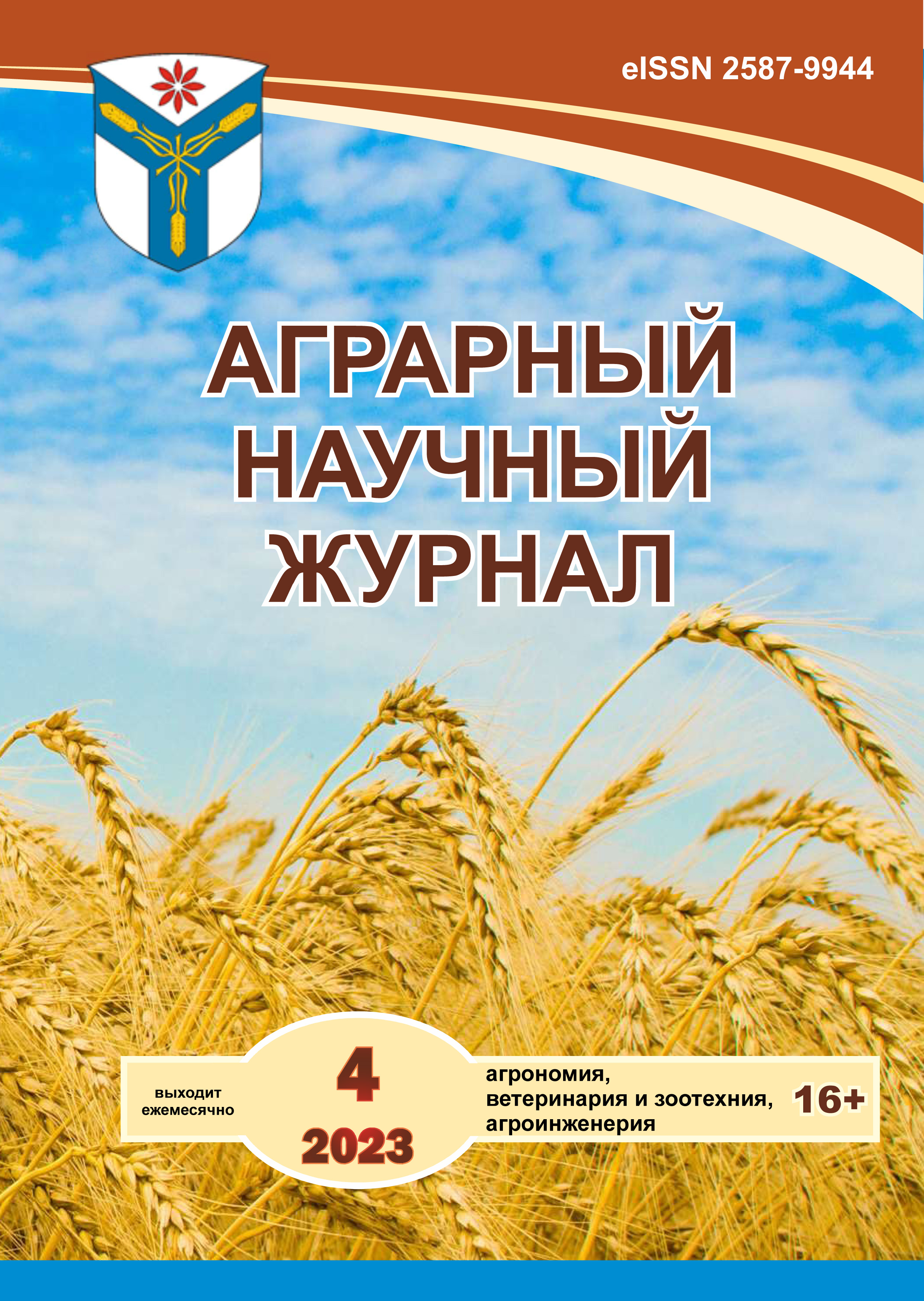Meat productivity of bulls of the Simmental breed and crossbreeds with blood relationship (? Simmental + ? Aberdeen-Angus), (? Simmental + ? Kalmyk)
DOI:
https://doi.org/10.28983/asj.y2023i4pp92-99Keywords:
crossing, Simmental breed, Aberdeen Angus breed, Kalmyk breed, height, meat qualities, morphological composition of carcassesAbstract
The aim of the study was to establish the characteristics of the meat productivity of steers obtained from crossing Simmental cows with Aberdeen-Angus and Kalmyk bulls, depending on the cultivation technology. Scientific and economic experiments were conducted in three farms of the Karachay-Cherkess Republic: LLC firm Hammer (experience 1); SEC PZ Zarya -1 (experience 2) LLC Yugagrohim (experience 3) in 2021-2022. For the entire period of cultivation in crossbreeds (? Simmental + ? Aberdeen-Angus) in the first experiment, the average daily increase was 711 g, 8.5 energy feed units were spent on 1 kg of increase, while the increase in Simmental bulls was 655 g per day, 10.4 EQ was spent on 1 kg of increase, or 22.35% more. The crossbreeds (? Simmental + ? Kalmyk) were closer to the bulls of the Simmental breed in terms of growth and payment of feed. In the first, second and third experiments, the crossbreeds (? Simmental + ? Aberdeen-Angus) outperformed purebred simmentals by: pre-slaughter live weight by 29.7 (P>0.999), 12.1 and 13.9 (P>0.99) kg; the mass of the paired carcass by -18.5, 8.9 and 8.6 kg (P>0.99 – 0.999); internal fat weight by – 3.1 (P>0.999), 0.6 and 2.4 (P>0.99) kg; slaughter weight by – 21.6, 9.5 and 10.2 kg (P>0.99–0.999); slaughter yield by -1,07,0,66 and 0.49 abs.%; half-carcass weight by 9.1, 4,5. and 4.5 kg (P>0.99–0.999); muscle mass by -6.13 (P>0.999), 3.0 (P>0.95) and 3.74 (P>0.99) kg; adipose tissue by–3.75 (P>0.99), 1.91 and 0.58 kg, respectively.
Downloads
References
Кравченко В. Рынок говядины: от роста производства – к экспорту // Животноводство России. 2022. № 10. С. 7–8.
Белооков А. А. Оценка экономической эффективности производства говядины в мясном скотоводстве при использовании в рационе молодняка ЭМ-препаратов // Аграрный вестник Урала. 2012. № 3 (95). С. 57.
Формирование мясной продуктивности бычков абердин-ангусской породы при различной длительности производственного цикла / А. Ф. Шевхужев [и др.] // Вестник Рязанского государственного агротехнологического университета им. П.А. Костычева. 2018. № 4 (40). С. 60–65.
Убойные качества чистопородного и помесного молодняка крупного рогатого скота / В. И. Косилов [и др.] // Известия Оренбургского государственного аграрного университета. 2021. № 2(88). С. 238–242.
Environmental factors influencing cattle's water consumption at offstream watering points in rangeland beef cattle / J.-A.C. Malan et al. // Livestock Science. 2020. No. 231. P.125–130.
Productivity and quality of meat from Kalmyk bull calves stimulated by immunomodulating agents / V. A. Pogodaev et al. // IOP Conf. Series: Earth and Environmental Science. 2021. Vol. 624. P. 012134 IOP Publishing doi:10.1088/1755-1315/624/1/012134.
Погодаев В. А., Сангаджиев Д. А Особенности роста бычков калмыцкой мясной породы крупного рогатого скота, полученных от кроссов разных линий // Известия Оренбургского государственного аграрного университета. 2021. № 1 (87). С. 243–246.
Раджабов Р. Г., Иванова Н. В. Мясная продуктивность бычков разных пород // Вестник Донского государственного аграрного университета. 2020. № 2-1(36). С. 9–14.
Мясная продуктивность и качество продуктов убоя чистопородных и помесных бычков / В. И. Косилов [и др.] // Мичуринский агрономический вестник. 2018. № 1.С. 26–32.
Годжиев Р. С., Гогаев О. К., Тукфатулин Г. С. Формирование мясной продуктивности молодняка крупного рогатого скота при использовании разных условий кормления // Известия Горского государственного аграрного университета. 2019. Т. 56. № 1. С. 86–91.
Гриценко С., Белооков А., Зайдуллина А. Оценка мясной продуктивности черно-пестрого скота с использованием генетических параметров // Молочное и мясное скотоводство. 2008. № 8. С. 13–14.
Кизаев М. А., Ажмулдинов Е. А., Титов М. Г. Продуктивные качества бычков различных генотипов при промышленной технологии производства говядины // Вестник Башкирского государственного аграрного университета. 2019. № 2(50). С. 78–81.
Шевхужев А. Ф., Погодаев В. А. Особенности динамики роста, экстерьера, оплаты корма бычков абердин-ангусской породы разного типа телосложения // Известия Тимирязевской сельскохозяйственной академии. 2021. № 2. С. 49–59.
Лумбунов С. Г., Гармаев Б. Д. Мясная продуктивность бычков калмыцкой породы разной селекции // Главный зоотехник. 2021. № 11(220). С. 31–46.
Acclimatization and productive qualities of american origin aberdeen-angus cattle pastured at the submontane area of the northern caucasus /
D. Smakuyev et al. Journal of the Saudi Society of Agricultural Sciences. 2021. Т. 20. № 7. С. 433–442.
Методика изучения откормочных и мясных качеств крупного рогатого скота. М.:ВАСХНИЛ, ВИЖ, ВНИИМП, 1977. 30 с.
Плохинский H. A. Руководство по биометрии для зоотехников. М., 1969. 256 с.
Downloads
Published
Issue
Section
License
Copyright (c) 2023 The Agrarian Scientific Journal

This work is licensed under a Creative Commons Attribution-NonCommercial-NoDerivatives 4.0 International License.








